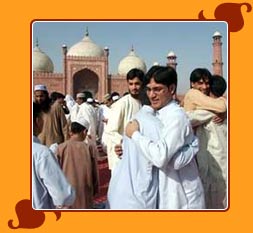Id Ul Fitr is a festival that
marks the end of the Ramzan period, and usually falls on a new moon night,
in the month of April or May. Ramzan is the ninth month in the Muslim
calendar. According to legend, the Holy Koran was revealed in this month.
Ramzan is thus regarded as highly auspicious month and fasting and prayers
mark it. Muslims keep a fast every day during Ramzan. The rituals associated
with Id and Ramzan have remained unchanged for centuries.

Muslims
through out the world and in India observe fast throughout this month and
eat and drink only in the night. All types of entertainments and ceremonies
are shunned during this period as it is exclusively meant to dedicate
oneself to Allah and show devotion by prayers at all the prescribed times,
reciting Quran and celebrating nights with feasts and family get- together.
Eid is the time for celebration and marks the happiness or festivity for the
men and women who follow the doctrines of Islam.
On the day of the
festival Muslims gather in large groups at mosques, and offer their prayers
or namaz. Id is one of the most important sacred festivals in the Muslim
religion. Muslim people from all strata of the society dress up in new
clothes to celebrate Id with great enthusiasm. Everybody greet each other on
this day. Special dishes are prepared on this day to mark the festive
occasion. Women prepare delicious sweetmeats at home, and vermicelli kheer
(sweetened milk) is a popular dish
People also do a lot of charity
on this auspicious day as a part of the festive rituals. Muslims in India
give gifts in kind or cash to the needy and poor. The first Eid of the year
is known as 'Eid-al-fitr' meaning 'breaking the fast'. The reason behind
keeping fast during Ramadan refers to the legend of the Prophet Mohammed who
left Mecca and undertook the journey to Medina in 622 AD, to join the other
Muslims who had migrated to Medina to escape persecution in Mecca.
During
this period, he fasted for three days. Many years later, He was to receive a
revelation from God, which stated that all followers of the Islam faith
fasted for a certain number of days. According to Islamic belief fasting
helps to develop self-control and a means of coming closer to Allah. It
purifies one's soul. The festival is a day of joy and thanksgiving. The
Muslims with great fanfare celebrate it. In India even Hindus also
participate in the celebration.
Islamic TraditionEid
al-Fitr marks the end of the fasting of Ramadan. This has to do with the
communal aspects of the fast, which expresses many of the basic values of
the Muslim community. Fasting is believed by some scholars to extol
fundamental distinctions, lauding the power of the spiritual realm, while
acknowledging the subordination of the physical realm.[2] The Islamic
tradition also associates events with the occasion. For example, on Eid
al-Fitr, the angel Gabriel descended with white clothes for each of prophet
Muhammad's grandsons.
Prophet MohammedProphet
Mohammed was born in 571 A.D on April12th, in Mecca in Arabia. Circa 610 AD,
Prophet is said to have gained revelations from Allah through the angel
Gabriel that he was His Messenger. In 622 AD Mohammed along with his
followers went to Medina. This flight from Mecca to Medina is known as
Hijrah and marks the beginning of the Islamic era. By 630 AD, Islam came to
be accepted as a religion and Muhammad as ruler by a large number of people.
However, in 632 A.D. Muhammad led the pilgrimage to Mecca, preached his
farewell sermon and died soon after.
Celebrations of
Eid-ul-MiladBarah Wafat does not call for any kind of grand
celebrations as the birth day and death anniversary of Prophet Mohammed
coincidently falls on the same day. Hence, Muslims spend this period in
spiritual activities. Special prayers meets and discourses on Quran are also
organised in mosques to mark the day of Milad.
Learned men and
scholars focus their sermons on the life and teachings of Prophet Mohammed
and inspire people to follow the path of good life as shown in Quran. Hence,
the festival gives a chance to people to introspect their deeds and think of
ways of being a better person. Besides, in some places hymns are sung and
elegies or marsiyas are recited in memory of the last days of the Prophet.
Acts of charity are also done by devout Muslims and alms are distributed to
the poor and the needy.
Later, people invite friends and relatives
for a feast. In some mosques, however, a ‘sandal rite’ ceremony is
performed over the symbolic foot prints of the Prophet engraved in a stone.
A stone imitation of buraq the horse on which Prophet Mohammed is said to
have ascended to his heavenly abode is placed near the foot prints and
anointed with sandal paste or scented powder. Besides, the house and casket
containing this are elaborately decorated.






